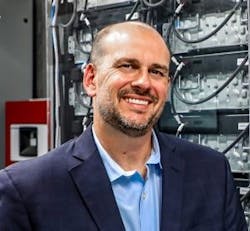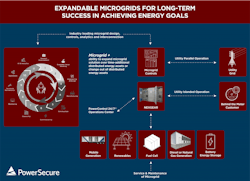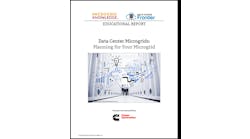If microgrids are the future, how can we future-proof microgrids?
Over the last few years, microgrid deployments have increased throughout the world. As more and more companies commit to reaching ESG goals and boosting resiliency, we should expect this trend in microgrid growth to continue along with increased government policies to adopt microgrid technology. As technology evolves, microgrid systems must be able to adapt to future innovations, minimizing future costs and avoiding stranded investments.
Working with a microgrid+ developer allows businesses to strategically forge ahead, build for their energy future, and protect current and future assets. A microgrid+ means the system has the ability to transition seamlessly from a basic to an advanced microgrid with inherent controls that enable a reliable interface and interaction with the utility grid, energy markets, and end-customers.In the next wave of the energy evolution, businesses will require technologies that better protect the end-user’s investment in their assets. This enables more flexible, expandable solutions that also support newer technologies, for a greener, cleaner, and more resilient microgrid experience.
Additionally, while many businesses are thinking ahead toward their 2030 or 2040 net zero goals — and awaiting fuels to become cleaner, more cost-effective, and widely available — the technology to get there is here, today. Diversified renewable fuels are drop-in ready solutions that can be used as a part of a total microgrid development and clean energy strategy. These flexible fuels can help businesses accelerate their path to net zero today, while also being ready to adapt to new and emerging technologies of tomorrow.
Microgrids are generation and energy storage facilities designed to achieve customer-specific requirements and objectives. A local cluster of energy resources that can operate continuously and independently for at least 24 hours, microgrids export energy and improve power quality of the local grid. When the grid is under strain or needs flexibility to balance resources, microgrids can autonomously support the host customer.
Not all microgrids are created equally. Given the evolving energy landscape and the need to design for both short-term and long-term business growth, a microgrid+ developer ensures that the core infrastructure of the microgrid is standardized, as well as ensures that the underlying DERs are selected to support the customer’s business objectives.
Depending on each customer’s specific challenge, the systems can be uniquely different and serve many different benefits.
A microgrid+ developer approaches customers’ needs using a well-rounded integrated delivery model. Beginning with concept and design, the care for each microgrid extends far beyond building and implementation. As an evolving and flexible system that’s built to be a long-term asset, each microgrid needs custom care, which can be accomplished through ongoing monitoring and maintenance, in addition to lifetime technology assessments.
Source: PowerSecure
There is much chatter around natural gas vs. Tier 4 Final ultra clean diesel engines, a narrative that has been played out. We need to get energized as an industry and flip the script. The reality is all DERs add value and there is a use for each of them. At PowerSecure, the conversation has been further broadened around fuel agnostic microgrids that have the flexibility to future proof the microgrid system. After all, the asset can last for 20 years. Over time, this flexibility will be valuable as technological improvement and innovation will allow our microgrids to work with a variety of low- to no-carbon options. As an industry, we must be committed to providing our customers with dependable solutions that support all future fuel technologies, continuing to enhance the value of the microgrid and to eliminate risk for our customers.
Renewable fuels are a modern and forward-thinking solution for future proofing. Renewable natural gas and renewable diesel are currently available for our customers in the U.S., as well as internationally. It’s important to make adopting renewable fuels easy, with drop-in ready fuels. This means clients can switch to renewable fuels today, and changes to existing assets and upfits are unnecessary. However, without incentives and other benefits, renewable fuels can come at a premium cost.
The world’s relationship with energy is rapidly changing, and organizations must prepare for the future of energy. To do this, we must define and deliver expandable, flexible, and clean microgrids that can adapt with energy evolution and eliminate risk for clients while enabling them to achieve their energy goals for a cleaner future, today.
Eric Dupont is chief development officer at PowerSecure.









